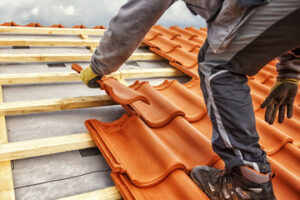Localized storm damage or a small section of missing or cracked shingles may be repaired instead of replacing your entire roof. This is also the case for leaks confined to a small area.

On the other hand, if water stains appear on your ceiling or walls, you should replace your roof as soon as possible to avoid further damage. For Free Estimate keep reading the article below.
Many roof problems are obvious and require immediate attention, such as severe leaks or extensive water damage. But others can be harder to see from the ground or even inside the house. That’s why it’s important to inspect the roof regularly. Here are a few things to look for:
Sagging areas of the roof. These can indicate problems with the decking or structural integrity of the roof. Missing or cracked shingles. These can allow water to enter the home and cause significant damage. Loose shingles can also expose the underlying materials to UV rays, which accelerates deterioration.
Inspect the gutters and downspouts for signs of clogging and blockages. If they are clogged, it can lead to water backup and damage the roof and soffit.
Check the flashing around roof penetrations, such as chimneys and skylights, to make sure it’s properly sealed. Water leaks around these areas can be hard to spot and can cause serious internal damage if left unchecked.
Inspect eaves and soffits for rot, warping, and cracking. These can allow water to enter the home, leading to serious damage and costly repairs down the road. Look for shingle granules in the gutters. These small pebbles help protect the shingles from UV rays, and their loss can indicate aging or damage.
Examine the attic for signs of moisture problems, including dark spots on the ceiling and walls and sagging or moldy insulation. A musty smell may also indicate a problem.
If you don’t feel comfortable climbing up on the roof, a professional can conduct a visual inspection. They can also perform a more thorough inspection using binoculars or a ladder. The professional will also examine the gutters and downspouts to make sure they’re free of clogs and debris, and that they are directing rainwater away from the house. They will also check the rafters and joists to make sure they are strong and free of damage or rot. They will also test for proper ventilation, which helps keep the home cool in summer and warm in winter.
Check the Outside
When it comes to roof repairs, the most important first step is a visual inspection. Start by looking from the ground at sagging areas or noticeable wear on the shingles, especially for tile roofs. Use binoculars if necessary, or climb up to take a closer look. Next, examine the gutters for damage such as rust or debris buildup, and check downspouts for proper drainage. Finally, look at the flashing (narrow strips of galvanized steel that get installed around areas such as chimneys or vents) for signs of wear or leaks.
The attic should also be inspected for moisture damage, which is a sign that the problem goes beyond the surface of the shingles. Dark spots on the ceiling and walls indicate water stains or damp areas, while a musty smell could mean mold or rot.
If the roof is under 15 years old and has been well maintained, it probably has more good years ahead. If it is older than that, however, and showing signs of aging, a replacement may be in order. Even if the shingle damage is isolated, such as a single missing or cracked shingle, it should be replaced to prevent further leaks and protect the rest of the roof structure. It is also a good idea to replace any insulation that has been compressed. This makes it less effective at keeping the home warm and dry.
Check the Slope
A sagging roof is usually a sign that structural damage has occurred, and it can be costly to repair. In fact, a complete replacement may be needed if this happens. However, if leaks are confined to a specific area, or the roof is under 15 years old and has been well maintained, a partial repair may be enough.
If you want to make sure your roof slope is correct, then the best way to do this is by measuring from the rafters. This is the more accurate method, as uneven roof tiles won’t affect your measurements. You’ll need a spirit level and a tape measure, and it’s preferable to work from inside your attic if you can as this avoids the risk of falling off a ladder onto your roof! Place the level against a rafter, either the overhang rafter at the end of your roof or the barge rafter to the side of the gable. Rest the bubble on the level against the rafter and adjust it until it reads 12 inches.
You can also check your roof’s slope by assessing any visible damage, such as water stains or fungus growth on the surface of your roof boards. This can indicate that too much water is collecting, causing the wood to rot.
If you see any of these signs, it’s a good idea to call in roofing professionals as soon as possible. This is to ensure that any repair work is done properly and prevent the issue from getting worse.
Check the Flashing
The flashing that’s around vents, chimneys, and skylights is another vulnerable area for leaks. When the flashing becomes damaged or separates from the roof, water can seep inside, causing rot and mold problems in the ceiling and walls. Timely repairs prevent these issues from worsening and prolong the life of your roof.
To repair the flashing, start by identifying the problem area. Look for areas of the roof that appear darker than the rest and inspect for rotting or damage to the underlying boards. Dark patches are a sign that water has been collecting there for a while, causing deterioration and requiring immediate repair. Blue stains indicate moss growth, which should be removed as soon as possible to prevent it from spreading.
Once you’ve identified the problem area, carefully remove any shingles or other roofing materials that cover or overlap the flashing. Using a pry bar or other tool, lift these materials to reveal the flashing. Next, clean the area thoroughly and scrape away any old sealant or debris that may have accumulated on the surface.
Once the surface has been cleaned, apply a waterproof sealant to the exposed edges of the flashing. When applying the sealant, pay special attention to any seams or areas where the flashing meets the roof. After the sealant has dried, reinstall the shingles or tiles that were previously removed. Make sure the flashing is tightly secured and the shingle/tile seams are well sealed to prevent water intrusion.
While a patch or simple repair might be sufficient for some roofing problems, a full replacement is often required to restore a roof’s integrity and water resistance. For example, if the underlying wood boards are rotting or showing signs of sagging, these problems will not be resolved by simply patching or replacing the shingles. In this case, it’s advisable to call in professional roofing contractors for a more extensive roof repair project.
